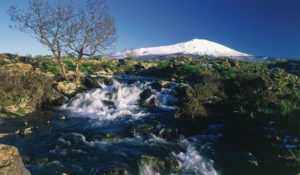


|
Considering just the arboreal essences on Etna, while climbing the volcano, you can find holm oaks and chesnut tree woods, gradually replaced by decidious oaks, downy oaks and turkey oaks. The oaks then make way for laricio pines, which can be found on all sides of the volcano, except for the Valle del Bove. The woods at their highest point feature lastly Common Aspen trees, beeches and silver birches. To the detriment of the continuous reconstructions of the mantle of vegetation, Etna has two patriarches: the ‘Castagno dei cento cavalli’ (The Chestnut tree of the 100 knights) said to be over 2000 years old and the’ Ilice di Carrinu’ (a centuries old oak), said to be 800 years old.
Wolves, wild boars, fallow deer and roe deer(which lived in the Maletto woods) roamed on Etna until the first half of the 1800s. Griffin vultures nested in the Valle del Bove, while otters caught fish in the Simeto River.
Unfortunately these animals which were rare, have now completely disappeared. Others have suffered the same fate (among them; martens and Eagle owls) and new species have arrived, such as the golden Eagle. The present fauna on Etna, even if impoverished and worn, boasts many amphibians (green frogs and common toads), reptiles (common tortoises, lizards, green whip snakes, leopard snakes, aesulapians and vipers), birds (sparrow hawks, buzzards, kestrels, pellegrin falcons, barn owls, scop owls, tawny owls, wood pigeons, some rare rock partridges and many passerines) and mammals (hedgehogs, shrews, porcupines, rabbits, hares, dormice, foxes, least weasels and a few rare wild cats). |